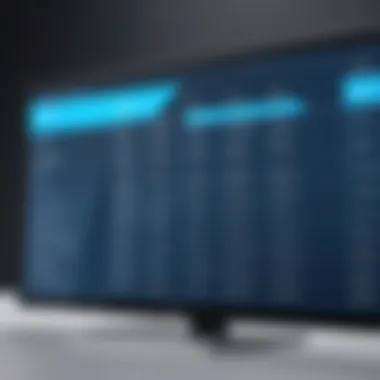Exploring Rental Lease Software: In-Depth Insights


Intro
In today’s fast-paced property management landscape, the adoption of rental lease software is not merely an option but a necessity. With numerous tools available, understanding the complexities and functionalities of these solutions is critical for decision-makers, IT professionals, and entrepreneurs. This guide aims to illuminate the characteristics and advantages of rental lease software, enabling informed choices for businesses of all sizes.
Rental lease software encompasses a range of applications designed to streamline the leasing process. From lease creation to tenant management, these tools fundamentally reshape how property managers operate. This comprehensive exploration covers essential software features, comparison metrics between leading products, and strategic consideration when selecting the appropriate software for unique business needs.
By presenting both the strengths and limitations of various options, this guide serves as a valuable resource for those navigating the often complex world of rental management technology.
Preamble to Rental Lease Software
In the rapidly evolving landscape of property management, the significance of rental lease software cannot be overstated. This software is essential for streamlining the complexities of managing lease agreements, automating processes, and maintaining organization. For property managers, landlords, and real estate professionals, understanding the capabilities of this software is imperative for effective management in a competitive market.
Definition and Scope
Rental lease software refers to tools designed to facilitate the management of rental agreements and associated tasks. The scope of this software extends beyond simple document creation; it incorporates various functionalities such as tracking payments, automating lease renewals, and managing tenant communication. By utilizing such software, property managers can centralize their operations, making it easier to access important information when needed.
The definition encapsulates a wide range of functionalities tailored to address specific needs in property management. This can include features like electronic signatures, customizable lease templates, tenant screening tools, and compliance tracking. Furthermore, today's software solutions often integrate with existing accounting systems and payment platforms to ensure seamless transactions.
Importance in Property Management
Understanding the importance of rental lease software is crucial for any organization involved in property management. One primary benefit is the increased efficiency it brings to the leasing process. By automating repetitive tasks, property managers can spend less time on administrative duties and focus more on building positive relationships with tenants and landlords.
Another significant factor is improved accuracy. Manual tracking of leases and payments can lead to errors, which can escalate into more significant problems down the road. Rental lease software minimizes these risks by offering features such as real-time updates and alerts for upcoming deadlines or missed payments.
Moreover, this software enhances communication between tenants and managers. With integrated messaging systems and online portals, tenants can access their lease agreements, submit maintenance requests, and track their payment history easily. This level of transparency fosters trust and satisfaction, which is essential in retaining tenants.
Incorporating rental lease software into operations also addresses compliance and risk management. Regulatory requirements for leases can be complex, varying by location. Rental lease software helps ensure that agreements adhere to local laws and regulations, thus minimizing potential legal risks.
"Utilizing rental lease software is not just about functionality; it is about aligning strategic goals in property management with technological solutions."
In summary, the introduction of rental lease software into property management processes serves as a comprehensive framework that enhances overall operational performance. Understanding both its definition and importance will set the stage for an informed exploration of advanced features and solutions that follow.
Key Features of Rental Lease Software
The Key Features of Rental Lease Software section outlines the essential characteristics that make these tools pivotal in enhancing property management practices. For users, understanding these features provides clarity on what to expect from rental lease software and how it can improve various aspects of leasing operations. By reviewing these functionalities, decision-makers can make informed choices that could lead to streamlined workflows, cost efficiencies, and improved tenant relationships.
Lease Management
Lease management is a core function of rental lease software. It encompasses the entire lifecycle of lease agreements, from creation to expiry. Efficient lease management simplifies numerous tasks which are often complex and time-consuming when done manually.
Utilizing lease management features enables property managers to quickly generate standard lease agreements using templates. This standardization helps in maintaining uniformity across documents. Furthermore, it assists in tracking key lease dates, such as renewals or expirations, avoiding potential lapses in agreements. Some software systems also integrate automated alerts to notify managers about upcoming deadlines.
Document Automation
Document automation is another critical feature of rental lease software. It facilitates the fast creation and customization of essential documents, such as rental applications and notices. This automation minimizes reliance on paper documents, thus promoting a more sustainable approach.
Automatic document generation saves time and reduces errors typically associated with manual data entry. Highlighted features often include signature collection tools, enabling seamless execution of contracts. By integrating cloud storage solutions, users can ensure that documents are securely stored and easily accessible.
Payment Processing
Effective payment processing capabilities are vital for any rental lease software. This feature streamlines the collection of rent payments, making it simpler for both landlords and tenants. Users can expect options for receiving payments through various channels, including credit cards, bank transfers, and even mobile payment solutions.
Having a comprehensive payment processing system in place can significantly reduce delays in cash flow and enhance tracking of payments, providing better visibility into financial status. Additionally, automated reminders for upcoming payments help in encouraging timely submissions from tenants, thereby lessening the workload on property managers.
Reporting and Analytics
Reporting and analytics functionalities provide insights that go beyond day-to-day management. Rental lease software equipped with these features offers various performance metrics that can aid in making strategic decisions. Regular reports on lease expirations, payment histories, vacancy rates, and tenant demographics are critical for assessing the health of a rental portfolio.
Utilizing data-driven insights not only enhances operational efficiency but also allows property managers to pivot strategies effectively based on market trends. Advanced versions of software might include predictive analytics to forecast future rental income or vacancy rates, which can further inform investment strategies.


"Integrating robust reporting and analytics enables landlords to make strategic, data-backed decisions that can enhance profitability and streamline operations."
Understanding these key features helps to appreciate the role they play in easing the complex processes involved in property management. By carefully selecting software with these capabilities, organizations can ensure they are equipped to handle the demands of modern rental management.
Benefits of Rental Lease Software
Rental lease software brings various notable advantages that transform how property management operates. It addresses critical business needs, providing significant value to property managers, owners, and tenants. The benefits related to efficiency, accuracy, communication, and compliance are essential for informed decision-making and long-term success.
Increased Efficiency
Efficiency is a primary benefit of rental lease software. By automating repetitive tasks and streamlining processes, teams can focus on more strategic activities. For instance, generating lease agreements can be completed in mere minutes instead of hours. This software often includes features such as automated reminders for lease renewals and rent due dates, significantly reducing administrative workload.
Moreover, integrations with accounting systems or maintenance request platforms ensure that all operations are seamlessly aligned. According to studies, businesses utilizing such tools report up to a 40% improvement in operational efficiency.
Improved Accuracy
Accuracy in financial reporting and lease terms is crucial for property management. Errors can lead to costly disputes and mistrust between landlords and tenants. Rental lease software improves accuracy by minimizing human errors through automated calculations and pre-filled documents.
These tools are also designed to stay updated with the latest regulations, ensuring that all lease agreements are legally compliant. Furthermore, audit trails allow managers to trace changes and revisions made to documents, enhancing accountability and trust across all stakeholders.
Enhanced Communication
Effective communication is vital in property management. Rental lease software often includes tools for direct communication with tenants regarding payments, maintenance requests, or policy updates. This creates a more transparent relationship between parties involved.
In addition, tenants may benefit from portals where they can access their documents and rent invoices, improving their experience. By centralizing communication, property managers can ensure timely responses and maintain clear lines of interaction, greatly enhancing overall satisfaction.
Compliance and Risk Management
The regulatory landscape surrounding property management can be complex and ever-changing. Rental lease software aids in compliance by providing up-to-date policy documents and reminders about important changes. With such tools, property managers can stay informed on local, state, and federal regulations.
Furthermore, risk management is another critical aspect addressed by this software. Many solutions include analytics tools that assess current trends and potential risks, enabling managers to make proactive decisions. Regular reporting can alert managers to any unusual or concerning patterns, improving overall risk preparedness.
"Utilizing rental lease software significantly enhances not only day-to-day tasks but also the strategic capabilities of property management professionals."
Considerations for Choosing Rental Lease Software
Choosing the right rental lease software is crucial for any property management operation. This decision impacts not only day-to-day functions but also the overall effectiveness of leasing processes. A well-chosen software solution can streamline tasks, enhance communication, and support compliance. As technology evolves, understanding the specific considerations for selection becomes essential.
User Interface and Experience
The user interface (UI) of rental lease software significantly affects user satisfaction and productivity. A clean, intuitive layout allows users to navigate the software with ease. This is important as property managers and staff may have varied levels of technical skill. If the software is complicated or unintuitive, it can lead to frustration and decreased productivity. Simple design elements, such as clear menus and accessible icons, contribute to a positive experience. Moreover, responsiveness across devices is fundamental, especially since many users rely on mobile access. An effective UI design minimizes the learning curve, enabling users to adapt quickly and focus on tasks rather than struggling with technology.
Integration with Existing Systems
The ability to integrate rental lease software with existing systems cannot be understated. Many property management firms utilize various software tools, from accounting programs to CRM platforms. Ensuring compatibility with these systems reduces the need for manual data entry, which can be time-consuming and error-prone. Integration capabilities might include APIs or built-in connectors that facilitate data exchange. When selecting software, consider how well it will communicate with your current tools. This oversight can significantly affect workflow efficiency. Therefore, proper integration enhances overall operations, fosters data consistency, and can improve decision-making processes.
Customer Support and Resources
Reliable customer support is a vital consideration when choosing rental lease software. The software provider should offer accessible support channels—like phone, email, or chat—so users can obtain assistance when needed. Additionally, comprehensive resources such as documentation, video tutorials, and FAQs can prove invaluable. These resources empower users to troubleshoot common issues independently. Furthermore, ongoing training opportunities provided by the vendor can facilitate better usage over time. Look for software solutions that emphasize customer service and resource availability. This focus can differentiate between a smooth implementation of the software and a frustrating experience.
Important Note: When evaluating software options, do not solely focus on price. Consider the long-term benefits and potential of the software to meet your needs effectively.
In summary, several critical factors are essential when choosing rental lease software. An emphasis on user interface design, integration capabilities, and robust customer support can significantly impact operational success in property management. Making informed choices leads to better outcomes and enhances overall workflow efficiency.
Top Rental Lease Software Solutions
The landscape of rental lease software is a vital component of property management. Identifying the optimal solutions helps businesses streamline operations, enhance tenant relations, and automate crucial processes. In this section, we will examine several aspects of the leading rental lease software products.
Overview of Market Leaders
Market leaders in rental lease software include platforms that provide robust functionalities designed specifically for property management. Among these are software such as Buildium, AppFolio, and TenantCloud. These companies offer comprehensive tools that address various needs within property management.


- Buildium: Provides a holistic approach to property management, combining lease tracking with tenant screening and financial reporting.
- AppFolio: Focuses on easy-to-use interfaces and mobile functionality, catering to real estate professionals looking for comprehensive management tools.
- TenantCloud: Offers features like property management and accounting in one platform, making it suitable for small and medium-sized landlords.
Each of these solutions brings certain strengths, making them popular choices in the market.
Comparative Analysis of Features
It's crucial to analyze the features offered by different software solutions. Not all software packages provide the same capabilities. Key areas to compare include:
- Lease Management: How each platform manages lease agreements.
- Document Storage: The ability to store and manage important documents securely.
- Payment Processing: How payments are handled; look for ease and efficiency.
- Tenant Communication: Features supporting interaction between landlords and tenants.
For instance, Buildium is well known for its comprehensive lease tracking, while AppFolio excels in its communication tools.
By assessing the strengths and weaknesses of each software against your specific needs, you will arrive at a more informed decision regarding the best fit for your business.
Pricing Models and Plans
Cost is a significant factor in selecting rental lease software. The pricing structures differ widely among providers, which can include:
- Flat Rate Pricing: A single monthly fee covers all features. This model is straightforward but might not fit every user's needs.
- Tiered Pricing: Different plans for various features, allowing clients to pay for what they use. This approach can be cost-effective for smaller operations.
- Pay-Per-Use Models: Clients are charged based on usage, which is suitable for those with fluctuating needs.
For example, Buildium charges a base price depending on property count, whereas TenantCloud offers free basic plans for small landlords while providing premium features for a fee.
Understanding these pricing dynamics allows businesses to choose software that aligns with their budget and operational requirements.
"Choosing the right rental lease software should be based on a clear understanding of both features and pricing structures to avoid surprises down the line."
By comprehensively analyzing these solutions, you can determine which rental lease software products will best meet your business needs and allow efficient property management.
Challenges Associated with Rental Lease Software
As the adoption of rental lease software expands, recognizing the challenges involved is crucial. These obstacles can impact the effectiveness of the solutions intended to enhance property management. Addressing these issues ensures that decision-makers can navigate potential pitfalls and capitalize on the advantages of such tools. Let’s explore these challenges in greater detail.
Implementation Hurdles
Implementing rental lease software often proves to be a complex task. The process requires careful planning and resource allocation. Common challenges during implementation include:
- Data migration: Transferring existing data to the new system can lead to inaccuracies if not done properly.
- Integration with other software: Ensuring the chosen solution works seamlessly with existing property management systems can be difficult. Failure to integrate can hinder workflow and efficiency.
- Training staff: Employees must be adequately trained to use the new system, which can be resource-intensive. A lack of proper training can lead to resistance from users and hinder successful adoption.
These hurdles, if overlooked, can disrupt daily operations and lead to a less than optimal return on investment.
Data Security Concerns
Data security is a primary concern when it comes to rental lease software. As property management involves sensitive information about tenants and financial transactions, the software must prioritize secure data handling. Key considerations include:
- Encryption capabilities: The software should provide strong encryption to protect data both at rest and in transit. This minimizes the potential for unauthorized access.
- Regular updates: Developers must release updates that address any identified vulnerabilities, ensuring that the software remains secure against evolving threats.
- User access controls: Systems may need customizable user access controls to limit who can view or modify sensitive information.
Addressing these data security concerns is essential to maintain trust among tenants and uphold regulatory compliance.
Resistance to Change
Resistance to change is a common hurdle in any organization, and adopting rental lease software is no different. It is natural for employees to be hesitant to transition from familiar processes to new technologies. This resistance may manifest in several ways:
- Fear of the unknown: Staff may worry about losing their jobs or their ability to perform well in a new system.
- Doubt in effectiveness: Employees may be skeptical about whether the software will improve their work processes.
- Cultural inertia: An entrenched work culture might resist new solutions, prioritizing established methods instead.
To mitigate this resistance, organizations should engage their teams early in the process. Involving employees in software selection and providing ample training can foster a sense of ownership and alleviate fears regarding the new system. Additionally, demonstrating the tangible benefits of the software can help assuage concerns and encourage a smoother transition.
Future Trends in Rental Lease Software
The landscape of rental lease software is continuously evolving. Understanding these future trends is crucial for professionals in property management. As industries shift towards greater efficiency and automation, the integration of new technologies becomes essential. This part of the article explores significant trends that are reshaping the future of rental lease solutions.
Adoption of Artificial Intelligence


Artificial intelligence is no longer a mere concept; it is rapidly transforming how rental lease software operates. By leveraging machine learning algorithms, companies can automate routine tasks such as tenant screening, lease analysis, and document management.
Key benefits include:
- Enhanced Decision-Making: AI can analyze large datasets to provide actionable insights, allowing property managers to make informed choices based on rental trends and tenant preferences.
- Cost Savings: Automating processes reduces labor costs and the potential for human error, making operations more efficient.
- Personalized Experiences: AI can enhance tenant interaction through chatbots and automated messaging, responding to inquiries around the clock.
Incorporating AI not only boosts operational efficiency but also improves tenant satisfaction.
Mobile Accessibility and Functionality
With the increasing reliance on mobile devices, rental lease software must prioritize mobile functionality. This trend is critical as property managers and tenants expect seamless access to data anytime and anywhere. Applications designed for mobile can facilitate:
- Real-Time Communication: Tenants can easily reach out for concerns, while managers can quickly communicate necessary updates.
- Responsive Design: Users can navigate complex features with ease on smaller screens, enhancing usability and engagement.
- On-the-Go Management: Manage property listings, respond to applications, and process payments directly from a smartphone.
Investing in mobile accessibility ensures that property management stays aligned with modern user expectations.
Integration with IoT Devices
The Internet of Things (IoT) brings another layer of innovation to rental lease software. IoT devices facilitate real-time monitoring and management of properties. For instance:
- Smart Locks: Property managers can offer keyless access to tenants, improving security and convenience.
- Energy Management Systems: These systems can monitor and optimize energy usage in buildings, leading to significant cost savings.
- Maintenance Alerts: IoT sensors can notify landlords of maintenance issues before they escalate, allowing for proactive solutions.
Integrating IoT devices into rental lease software not only boosts efficiency but also enhances the overall tenant experience. By staying ahead of these trends, property managers can greatly improve their service quality and operational effectiveness.
In summary, staying informed about future trends in rental lease software is crucial for adapting to the changing landscape of property management. Integrating artificial intelligence, ensuring mobile accessibility, and leveraging IoT capabilities will be paramount for enhancing tenant satisfaction and operational efficiency.
The End
The conclusion section plays a vital role in synthesizing the core insights presented throughout this article. It serves to encapsulate the key elements discussed while ensuring that the reader is left with a clear understanding of the significance of rental lease software in property management.
Recap of Key Points
In summary, rental lease software revolutionizes the management of properties by streamlining various processes. The article highlighted several important aspects:
- Definition and Scope: It is essential to recognize what rental lease software encompasses. It includes functionalities ranging from lease management to payment processing, allowing for efficient handling of property-related tasks.
- Key Features: Critical features like document automation and reporting tools contribute to enhanced efficiency. Different options in the market provide functionalities that can be tailored to the specific needs of property managers.
- Benefits: Significant advantages include increased efficiency, improved accuracy, and capability for enhanced communication with tenants.
- Considerations for Selection: Evaluating user interface, integration hurdles, and the quality of customer support are key before making a decision.
- Future Trends: Increased adoption of technologies such as AI and IoT will further shape the landscape, making these tools more indispensable than ever.
Final Thoughts on Adoption
Adopting rental lease software serves not just as an operational change, but rather as a strategic move for businesses aiming for growth in their property management endeavors. While challenges may arise during implementation, such as resistance to change and data security concerns, the long-term benefits usually outweigh initial hurdles.
Investing in such technologies aligns with modern demands and promotes better management practices. A thoughtful approach to selecting the right software can transform operations, leading to better client relations and enhanced profitability over time. As the industry evolves, staying informed and adaptable will ensure that property managers remain competitive in a rapidly changing landscape.
"In the realm of property management, informed decisions are the cornerstone of sustainable success."
For further exploration of the evolving landscape of rental lease software, resources like Wikipedia, Britannica, Reddit, and Facebook can provide valuable insights and community discussions.
Resources for Further Reading
In the complex world of rental lease software, obtaining reliable information is crucial for stakeholders. This section emphasizes the need for well-researched resources that can provide more detailed insights beyond this article. Leveraging external resources enables property managers and decision-makers to foster informed choices, ensuring that they align their practices with emerging trends and standards. Here, we focus on two primary categories: industry reports and publications, alongside comparative guides and reviews.
Industry Reports and Publications
Industry reports are essential for understanding broader market trends and shifts in rental lease management. They typically present data gathered from extensive research, offering insights that reflect the current state of technology adoption within the property sector. Here are some key benefits of engaging with this material:
- Informed Decision-Making: These reports provide aggregated data which can guide managers in selecting solutions that comply with evolving industry standards.
- Benchmarking Performance: By examining these documents, organizations can compare their practices and outcomes against industry benchmarks.
- Identifying Risks: Industry reports often outline potential risks and challenges in rental lease management, allowing businesses to prepare proactively.
A few significant publications include reports from organizations such as Deloitte and PwC, which frequently analyze technology impacts on property management. These resources are an invaluable asset for those looking to stay compliant and competitive.
Comparative Guides and Reviews
Comparative guides and reviews are instrumental for decision-makers who are evaluating multiple rental lease software solutions. They consolidate user experiences, expert opinions, and feature comparisons into digestible content. Here are some considerations when exploring these resources:
- Feature Comparison: These guides break down the features of different software options—helping users to easily identify which platform suits their operational needs.
- User Feedback: Incorporating real user reviews offers insights into the practical pros and cons of each software, beyond what marketing materials present.
- Cost Analysis: Many comparative resources include pricing models and potential ROI calculations, which are critical for financial planning.
Platforms like TechCrunch and G2 provide extensive reviews and comparisons, helping managers sift through the options available in the marketplace. Engaging with such guides ensures that investments into rental lease software align with business objectives and operational efficiency.
"Even the best technology can fall short if it is not chosen wisely." By utilizing industry reports and comparative guides, property managers can enhance their expertise and ensure their practices are optimized for today’s challenges and opportunities.



